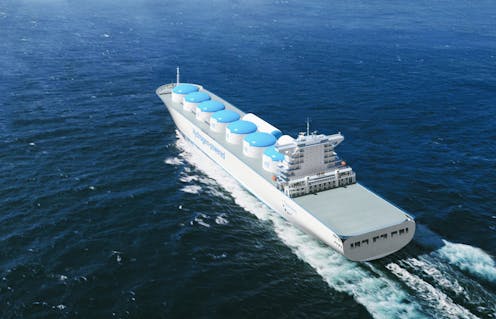China is gunning for supremacy in the global green hydrogen race. Will it shatter Australia's dreams?
- Written by Hongzhang Xu, PhD Candidate/Research Associate, Australian National University

This week’s report by the Intergovernmental Panel on Climate Change (IPCC) warns global warming is headed for dangerous levels unless greenhouse gas emissions halve this decade. This cannot be achieved without a huge effort from China, the world’s biggest emitter.
The IPCC says limiting global warming will require, among other measures, a substantial reduction in fossil fuel use and deploying alternative fuels such as hydrogen.
China is responsible for almost one-third of global emissions each year. It’s committed to becoming carbon neutral before 2060 – and producing green hydrogen is key to this plan.
Australia is also pouring millions of dollars into green hydrogen technology. But China’s new plan could throw cold water on Australia’s dream of becoming a global hydrogen superpower.
Stiff competition
There’s much talk about hydrogen’s various roles in the global economy as the world races to decarbonise.
Hydrogen is an energy carrier – it holds the energy used to extract it. It can be produced without emissions – as “green hydrogen” – using solar and wind energy, nuclear or hydropower. It can also be produced from fossil fuels such as gas and coal.
Hydrogen is versatile. It can be used for electricity and to power vehicles. It can also help produce ammonia, chemicals and petrochemicals, glass and metals.
Australia’s extensive solar and wind resources mean it’s well placed to produce green hydrogen. And our proximity to Asia means we’re well-located to export hydrogen there.
The federal government wants to ship hydrogen to the world – creating an export industry to replace Australian coal and gas, demand for which will fall as global climate action ramps up.
In the past few years, China has been touted as a major prospective export market for future Australian hydrogen, largely due to an expected rise in its use of hydrogen fuel cell-powered vehicles.
The location of onshore wind and solar power capacity in western China, far from much of its energy demand in the east and on the coast, also led to perceptions the nation had only limited capacity to generate green hydrogen.
However, China’s hydrogen picture is fast changing.
Read more: IPCC finds the world has its best chance yet to slash emissions – if it seizes the opportunity
China throws down the gauntlet
Late last month, China released its first national plan to develop a domestic hydrogen industry out to 2035.
It includes mastering technologies and manufacturing processes, coordinating the construction of hydrogen energy infrastructure, and improving policy and industry standards.
It also involves a phased introduction to industry sectors by 2035 and restricting hydrogen produced from fossil fuels.
China’s green hydrogen production is expected to reach up to 200,000 tonnes annually by 2025, avoiding up to two million tonnes of CO₂ each year.
It appears increasingly likely China will not need to import Australia’s green hydrogen – and will compete with us as a green hydrogen exporter.
Cleaning up industry
The IPCC report said industry accounts for about a quarter of global emissions. It warned achieving net-zero in the sector will be challenging, and will require new production processes including hydrogen.
China’s manufacturing sector is a major contributor to its national emissions – particularly energy-intensive cement and steel production.
Making steel involves removing oxygen from iron ore to produce pure iron. Historically this has been achieved using coal or natural gas, which releases a lot of CO₂.
But hydrogen can be used in steelmaking to replace fossil fuels.
For China, the benefits of home-grown green steel are twofold. As well as slashing national emissions, it would reduce China’s reliance on imported coking coal and iron ore from nations such as Australia.
So how will China produce hydrogen?
Fossil fuels account for almost all China’s current hydrogen production.
In theory, coal-based hydrogen can be produced cleanly if CO₂ from the process is captured and stored. This is considered a potential hydrogen production route in China.
But the method is notoriously complicated and expensive, and importantly, does not capture all CO₂ emitted.
As nations seek to reduce their emissions, an export market for coal-based hydrogen – even when some emissions are captured – cannot be assured.
Read more: For hydrogen to be truly 'clean' it must be made with renewables, not coal
To produce green hydrogen, China would probably use a combination of nuclear and hydropower – the nation’s two cheapest non-fossil fuel sources of energy.
Many coastal regions in China are investing in producing green hydrogen from surplus nuclear energy. And there are moves to use nuclear to produce hydrogen for steelmaking.
Hydroelectricity is another option to produce hydrogen in China. It’s a low-cost energy source, and is often produced in excess in the Sichuan and Yunnan provinces.
However, development of nuclear and hydropower capacity in China, as elsewhere, comes with risks and social costs.
For example, the creation of dams for hydropower can rob local communities of their livelihoods. And Japan’s Fukishima disaster – and more recently, Russian threats to nuclear facilities in Ukraine – show the potential for nuclear disasters.
Looking ahead
Australia has spent big on hydrogen of late – most recently in last month’s federal budget, which allocated hydrogen a share in A$1.3 billion for new energy infrastructure and development. The private sector is also splashing cash on the technology.
But Australia’s hydrogen strategy appears too optimistic about our export prospects. As others have noted, Japan’s demand for our green hydrogen also seems to have been overstated.
Australia needs more detailed plans for securing trading partners in green hydrogen. And it should highlight the comparatively lower risk of investing in Australian hydrogen produced from solar and wind, compared to the plans of our global rivals.
Authors: Hongzhang Xu, PhD Candidate/Research Associate, Australian National University





